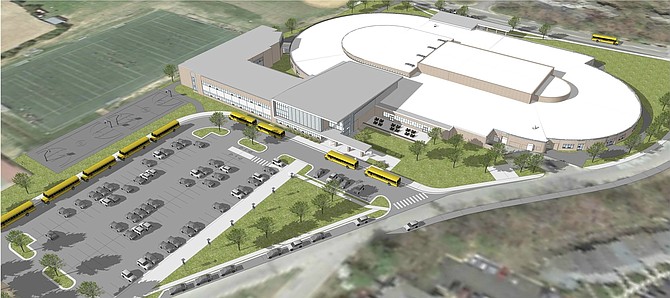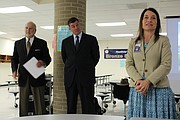The preliminary concept of the renovation at Langston Hughes Middle School will add a two-story addition to the front, a kiss and ride to the rear and a new roof. Courtesy of Hughes Group Architects
Septage Study Surfaces
In October 2014, the Fairfax County's Wastewater Management Program began a Septage Receiving Site Feasibility Study to review the operations of the county's two septage receiving facilities.
These facilities are used to dispose of septic tank, portable toilet and restaurant grease-trap waste. The study was to assess the future need of the septage receiving program and identify potential sites to replace the facilities serving the northern half of the county, which were aging and becoming obsolete.
The study identified 972 potential sites, but only 76 sites met the team's minimal stated criteria: a 16-inch sewer line and road access; industrial or commercial zoning or government-owned; greater than 225 feet from the nearest residential parcel; and parcel the size of at least one acre and located outside the floodplain.
However, the county decided not to pursue the construction of a new facility to replace the existing north county site, the Colvin Run Septage Receiving Facility. Instead, the county is permanently closing the facility.
The high costs of purchasing property and constructing a new facility makes it impractical to recover expenditures through reasonable service fees, according to a press release issued by Supervisor Catherine Hudgins’ office.
The county will continue to rely on alternative disposal options that were instituted during the temporary closure of the Colvin Run Facility, according to Hudgins. These options include the Noman M. Cole Pollution Control Plant, the Upper Occoquan Service Authority facility, and the D.C. Water's Blue Plains facility.
They have worked effectively and will be able to meet future needs, Hudgins said in a press release.
Reston Community Center Board To Vote On Pool Renovation
The Reston Community Center has been exploring ways to revamp its pool for its community swimmers.
The RCC Finance Committee received a final report from the Hughes Group Architects that examined possible renovation of the Terry L. Smith Aquatics Center during its meeting on Monday, April 17.
“The pool environment is nearly 40 years old,” said Leila Gordon, the community center’s executive director. “We opened in May of 1979.”
It became clear to Gordon and her staff that the cost to maintain the facility over the next two years would be significant. The costs for needed repairs were estimated around $1.2 million, according to Gordon.
“Our pool is not going to be safe pretty soon because all of the systems that it depends on for its public safety and effective operation have aged to the point of their end of useful life,” she said. “Over the next two years, some level of significant capital construction will have to take place at that pool environment.”
Therefore, a conversation with the Reston community about investing in an overhaul and renovation of the pool started in February. Three concepts were originally reviewed
- Concept One: Two bodies of water: One significantly larger pool with lap lanes and another with warmer water for therapy-oriented exercise.
- Concept Two: Three bodies of water: Two bodies of water that are similar in size of the center’s existing pool, with an additional third body of water with warmer water for therapy-oriented exercise.
- Concept Three: Two bodies of water: Reconfigure and rebuild the center’s existing lap lane pool to separate it into two bodies of water. One would have warmer water for therapy-oriented exercise.
Preliminarily, the Hughes Group estimated costs associated with the first two concepts as being in the $7 to $8 million range and costs associated with the third concept as being in the $3 to $4 million range, according to Gordon.
“We know from years of anecdotal input and feedback, the fact that we just have one body of water now is frustrating across every cohort of swimmer type,” Gordon said. “We have to set the temperature of this pool at a point that is too warm for people who want a very high-energy or competitive swimming experience and it’s too cool for swimmers who want a more therapeutic, or for the littlest swimmers, just a more comfortable swimming temperature … No one is truly comfortable with the existing temperature.”
Given those factors and budget constraints, the center will be further exploring the third concept. However, a vote of approval is required.
The Finance Committee unanimously recommended that the RCC’s full board pursue the third option. A two-thirds majority of the center’s Board of Governors will be required to allow Gordon to take the steps needed to incorporate costs related to renovation of the pool in its fiscal year 2018 and 2019 budgets and to continue the process of advancing the project.
An approval of the full board would signify the “end of the beginning and beginning of the middle of this process,” Gordon said.
Design considerations and decisions will be handled during regular public meetings of the board in the coming months, according to Gordon.
If the process is put in motion, construction would require approximately nine months of work, with a timeline of closing the pool on June 1, 2018, and re-opening on April 1, 2019.
“We want to time our closed period as closely as possible with the outdoor pool season in Reston,” Gordon said.
The board will vote on whether to continue the process on May 1.
Reston Referendum Will Determine Middle School Renovation
Construction to renovate the Langston Hughes Middle School is planned to begin in 2019, if Restonians vote to approve the work in a bond referendum next year.
“We won’t build it if [the referendum] fails,” said Brady Rauch, an employee of the Fairfax County Public Schools Office of Design and Construction. “We won’t have funding for it.”
Rauch and the Hughes Group Architects presented preliminary designs for the renovation during a community meeting at the school on Thursday, April 20.
“The building is in good shape,” said Aimee Monticchio, the school’s principal. “It just needs a facelift.”
Big plans are in store for the building.
“We’re keeping a lot of the exterior of the existing, but the interior is being reconfigured substantially,” said Gavin Myers, a principal of the Hughes Group Architects.
“There’s not much we don’t touch,” Rauch added. “We’re going to replace the flooring, the electrical system, put in a sprinkler system, all new windows, new fresh paint, HVAC. It’s essentially a complete renovation. Everything we touch gets put in brand new.”
Major proposals include:
- A new two-story addition with an elevator for the front of the building to house administration offices, a library and science classrooms
- A revamped Hall of Nations to run through the center of the building
- Collaborative space and lecture hall with a capacity of 650 chairs
- A small kiss and ride addition to the rear of the building that will comply with the federal Americans with Disabilities Act
- An outdoor courtyard
- Stormwater management upgrades
- 60 more parking spaces in the parking lot
- A new roof with a Solatube system
- All new windows
- Expansion of the cafeteria
- Expansion of art room
The architects are striving to receive certification from the Collaborative for High Performance Schools, which encourages schools to be built with sustainability standards.
Installing a Solatube system is one way the design is more sustainable than the current building. The tubular devices will be installed throughout the roof to allow natural daylight in.
“In the main gym, we’ll have these Solatubes,” said Joe Saunders, a senior associated with the firm. “It will allow us to do what we’re calling daylight harvesting. On a nice great sunny day, we might not even have to have the gym lights on.”
The work will be phased over three years.
“Our idea is to build the [new two-story] addition first,” says Rauch. “You’ll have all of that built-in space where it’s basically just a flow chart. Whatever we turn over new to the school, we take inside the building and renovate … Any space that is used every day by every kid, like the gyms and the kitchen and cafeteria, we’ll have to do during the summertime.”




